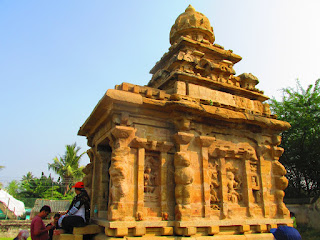Piravadeeswarar Temple, Kanchipuram
Kanchi Puranam mentions this temple. It is also called Piravadeeswarar Temple or Apunarbhaveswarar Temple. The word "Pirava" in the Tamil language indicates preventing rebirth. Similarly, the Iravadeeswarar temple is nearby, indicating something related to death (Irava).
As per the legend, the sage Vamadeva prayed to Lord Shiva to bless him, not to have rebirth. The sage was in the womb of his mother while praying. Shiva advised him to visit this site to fulfill his wish. Accordingly, after the sage was born and grew up as an adult, he came to Kanchipuram, installed Shiv Linga on this site, and performed poojas. To relate this legend to this site, it is called Piravasthanam.
Although the temple has no stone inscription, as per the architectural style, scholars believe it was built by Rajasimha Pallava at the beginning of the 8th century CE. Also, it is believed that it was his first temple in this city.
The west-facing temple is small and has just the sanctum and a small Ardha Mandap. Shiv Linga, named Privadeeswarar, is found in the sanctum. The vimana looks artistic and has two tiers. The griva portion of the vimana has 16 bars, and its shikara has 8 bars. Nasi koshta has attractive miniature sculptures. The miniature icons of Bhoota Ganas in different forms are also found in the top portion of the vimana.
The walls around the temple have exquisite sculptures. Six standing horned lions (Vyalas) are found at the corners of the temple.
The images of Durga and Jalandhara Samhara Murti are found on the northern side wall. Durga is a typical Pallava Durga sculptural style. She has her left leg resting on the lion; she has four arms and holds a bow in her left arm. Shiva is found in yogic posture, with his discus slaying the head of Asura Jalandhara. He is flanked by Brahma and Vishnu and then by two Dwarapalas.
The eastern side wall has Shiva in the dancing form. This form of dance is called Vrschikam karana. The sculpture is partially destroyed and is not very clear. He is flanked by two figures, probably Brahma and Vishnu.
The southern side wall has Dakshinamurti and Gaja Lakshmi. These sculptures are also partially destroyed and not very clear. The icons around Dakshinamurti are not clearly visible except for a lion and two sages.
In the open ground where this temple is located, there is also a new shrine for Shiva of a later period. The walls of the shrine have some old paintings of Ganesh and Kartikeya.
Happy travelling.
P.S. Thanks to Kanchipuram Dr. Sankara Narayanan, a great scholar. I have used some information shared by him in this blog post.















.JPG)
Comments
Post a Comment